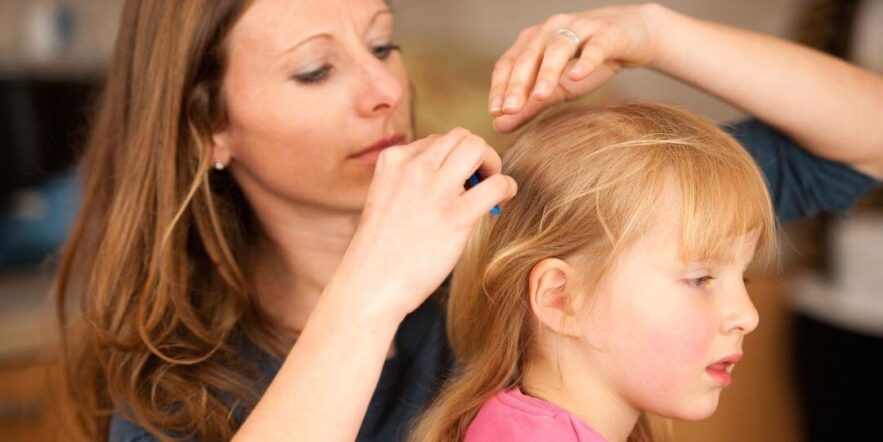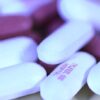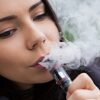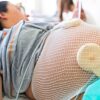Lice are a fact of life for many people. They most commonly affect school-age children and the adults who live or spend the day with them. It doesn’t matter how many times we hear that lice are not a sign of uncleanliness and don’t carry disease, most people still want them off their head as quickly as possible.
There are many different kinds of treatments that are used in the hair to eliminate lice. But which ones are the safest and most effective?
Browse This Article
Common Names
Over-the-counter pediculicides: RID and Nix (both permethrin or pyrethrins). Other OTC products: ClearLice (shampoo with only natural ingredients); aerosol sprays to treat pillowcases and couches. Prescription products: Sklice (ivermectin), Natroba (spinosad), Ulesfia (benzyl alcohol), Lindane lotion, Ovide (malathion)
Side Effects and What to Do About Them
RID and Nix have been used for more than 30 years. However, they’ve never been thoroughly examined for long-term effects. The AAP (American Academy of Pediatrics) is satisfied that they are safe for children and adults. Rashes and eye irritation are occasionally seen but considered relatively rare.
Sklice is effective without the need for combing afterward for the nits. It was first approved in 1996 and it seems to have the usual side effects found in OTC lice treatments — skin burning sensation, dry skin and eye irritation, swelling. A study published in 2013 in the Annals of Pharmacotherapy notes: “Although it has no documented resistance, there is limited clinical experience, it requires a prescription, and it is expensive. Therefore it should be reserved as a third-line treatment for head lice in the United States.”
Natroba’s active ingredient, spinosad, is organic, derived from bacteria in soil that paralyzes the lice and nits. It does not require combing out the nits and a low percentage of patients experienced the typical side effects of itchiness, redness, eye irritation and swelling. Limited research finds it safe, but being new (approved by the FDA in 2011), it hasn’t had a lot of real-life testing and long-term effects are not known.
ClearLice treatment products are sold online. The company claims the products contain “natural ingredients, botanicals, enzyme complexes, and plant extracts. They work with one another to mimic the molting process of head lice to disrupt their life cycle.” The first ingredients listed are enzyme proteins that they say “break down and digest the nit glue and break open the protective shells of the lice and nits.” The other ingredients are tree oils and other essential oils (oils are unproven to affect lice and have unknown toxicity on the child’s head). We could find no research to prove efficacy or safety. The company says that no specific harmful reactions to date have been reported by customers.
Ulesfia is available only by prescription. It is applied topically and kills the living lice by asphyxiation. It doesn’t kill the eggs, necessitating a second application 7 days later unless all nits are successfully combed or picked out. According to the Environmental Working Group, the active ingredient, benzyl alcohol, is a “naturally occurring and synthetic ingredient used as solvent and preservative; has been associated with contact allergy.” It’s found in small amounts in many cosmetics. There are not many reports or studies on either side effects or long-term effects. Side effects that have been reported are itchiness, redness and slight swelling.
Lindane lotion is generally used to treat scabies, a much more serious skin condition. The FDA issued a Public Health Advisory in 2015 warning against using it as a first choice because of severe side effects and because safer and equally effective products are available. It has been known to cause seizures.
Ovide kills both the lice and their eggs. Side effects include burning, dry or itching eyes, changes to vision, stinging or irritation on scalp or skin.
Home and Non-Medicine Remedies
Using a nit comb with conditioner is a common choice. Using a thick, white conditioner enables the comber to see nits and lice. It’s time-consuming and painstaking work but seems completely safe.
Rosemary hair conditioner has anecdotal ability to repel lice.
Vaseline (petroleum jelly), olive oil and mayonnaise have not been studied in controlled studies, but research following use in the home shows that they are each ineffective. Applying Vaseline, olive oil or mayo can make lice look dead because it lowers metabolic activity, but the lice awaken after a short time, a condition known as the “resurrection effect.”
Tea tree oil (melaleuca alternifolia) is often suggested on homeopathic websites. Not much is known about its effectiveness or toxicity, but here’s a thoughtful slideshow about it from Healthline.com.
Professional Companies with Proprietary Products
In general, the companies we found will either come to your home or operate a salon where they comb out nits and lice from hair using their own products. In researching their websites, we found most of them used nit combs and a proprietary shampoo and conditioner, also for sale. Sometimes the ingredients were available, but often not. Many use tea tree oil and essential oils. Note the risks of such oils below under Effectiveness & Considerations.
Treating Infected Living Spaces
Head lice are parasites and can live only 24 hours when off a human host. Therefore, there is little need to treat areas that infected scalps might have touched with strong pesticides. Most often washing (or dry cleaning) bed linens and clothing will effectively rid them of any trace of lice or nits. The high heat of a clothing dryer is considered effective at killing lice and nits.
Vacuum any rugs, pillows or stuffed toys that might be carrying lice. Isolate any items that can’t be easily vacuumed or laundered for a few days until any lice and nits have died.
Sprays are occasionally used but are an unnecessary exposure to chemicals.
Effectiveness & Considerations
The effectiveness of Nix and RID has been declining for the past 20 years. This is almost certainly from overuse. For many years, RID and Nix were the only treatments commonly used, and lice are developing a resistance to them.
If the first treatment of any of the medical lotions or shampoos is not effective, use a different method or medicine for follow-up. Using a single medicine multiple times encourages resistance to it among the lice and exposes the user (child or adult) to too much medicine unnecessarily.
Essential oils can be potent and penetrate the skin to enter the body’s systems. There has been little testing on safety for adults and none for children. Use with caution.
The NPA (National Pediculosis Association) warns against the use of any chemicals designed to kill or destroy head lice (http://www.headlice.org/faq/questions.htm) in any individuals with a pre-existing illness. This includes, but is not limited to, those with asthma, epilepsy, brain tumors, cancer or AIDS. Those on medication, or who have been previously treated for head lice, as well as pregnant and nursing mothers, may be more vulnerable to side effects and should avoid chemical lice treatments for use on themselves or applying them to others.
Drug Interactions
Very little of RID or Nix is absorbed into the bloodstream from the scalp, so interactions should be minor. Sklice also has limited absorption into the scalp.
Oils do tend to get absorbed into the body, so check with your doctor about medical interactions.
How They Work
Using a fine-toothed “nit” comb attempts to remove live lice and nits by direct removal. Most of the medicines kill the lice and nits but also recommend combing. Neither method is 100% successful. Nits are particularly difficult to remove from the hair shaft (they are glued on) and difficult to kill with medicines.
Here is an illustration of the lifecycle of a louse







